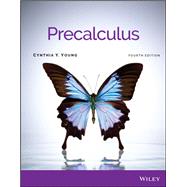Cynthia Young's Precalculus, 4th edition helps students take the guesswork out of studying by offering them an easy to read and clear roadmap that tells them what to do, how to do it, and whether they did it right. With this revision, the author focuses on the most difficult topics in precalculus, bringing clarity to challenging learning objectives.








